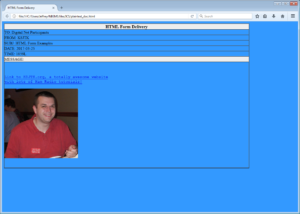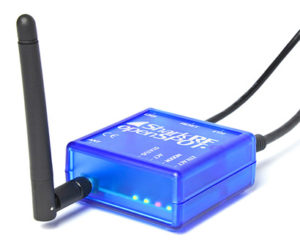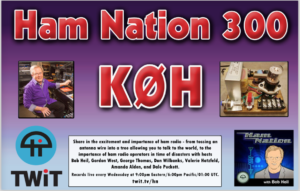One of the responsibilities of the Technical Coordinator in the Ohio Section is to submit something for the Section Journal. The Section Journal covers Amateur Radio related things happening in and around the ARRL Ohio Section. It is published by the Section Manager Scott – N8SY and articles are submitted by cabinet members.
Once my article is published in the Journal, I will also make it available on my site with a link to the published edition.
You can receive the Journal and other Ohio Section news by joining the mailing list Scott has setup. You do not need to be a member of the ARRL, Ohio Section, or even a ham to join the mailing list. Please sign up!
If you are an ARRL member and reside in the Ohio Section, update your mailing preferences to receive Ohio Section news in your inbox. Those residing outside the section will need to use the mailing list link above.
Updating your ARRL profile will deliver news from the section where you reside (if the leadership chooses to use this method).
Go to www.arrl.org and logon.
Click Edit your Profile.
You will be taken to the Edit Your Profile page. On the first tab Edit Info, verify your Email address is correct.
Click the Edit Email Subscriptions tab.
Check the News and information from your Division Director and Section Manager box.
Click Save.
Now without further ado…
Read the full edition at: http://n8sy2.blogspot.com/2017/04/april-edition-of-ohio-section-journal.html
THE TECHNICAL COORDINATOR
Jeff Kopcak – TC
k8jtk@arrl.net
Since the last couple months have been feature articles, this month will be odds-n-ends.
Maker Spaces & Faires
I got positive comments on last month’s article about Makerspaces and Maker Faires. I hope it gave clubs and groups ideas to get younger makers into our hobby. Not only did the January edition of QST have the article on Maker Faires but it was the focus of ARRL CEO Tom Gallagher – NY2RF’s note in April. I’m happy to say these types of things are on the radar of the League and they’re focusing efforts on this new generation of Ham Radio operators. According to Tom, the ARRL plans to be at the three national maker events this year.
AllStar
 I learned the creator of AllStar Link, Jim Dixon – WB6NIL, passed away at the end of last year. Jim is the creator of “app_rpt” which allowed the open source PBX system, Asterisk, to function as a repeater controller. In doing so, created one of the most impressive and versatile solutions for VoIP (Voice over Internet Protocol) in ham radio. Having played around with AllStar on my own node, nodes can be linked together directly through the public Internet, private network, point-to-point network, or really any combination of methods. Hubs are systems with greater bandwidth allowing for multiple simultaneous connections – like “reflectors” on IRLP or “conferences” on Echolink. One of my buddies who spoke with Jim commented that he was the smartest, nicest guy you’d meet and [he] would be doing well if he retained even half of what they talked about. Jim will be missed but the AllStar project will live on. AllStar Link: https://allstarlink.org/, Raspberry Pi & BeagleBone image: https://hamvoip.org/
I learned the creator of AllStar Link, Jim Dixon – WB6NIL, passed away at the end of last year. Jim is the creator of “app_rpt” which allowed the open source PBX system, Asterisk, to function as a repeater controller. In doing so, created one of the most impressive and versatile solutions for VoIP (Voice over Internet Protocol) in ham radio. Having played around with AllStar on my own node, nodes can be linked together directly through the public Internet, private network, point-to-point network, or really any combination of methods. Hubs are systems with greater bandwidth allowing for multiple simultaneous connections – like “reflectors” on IRLP or “conferences” on Echolink. One of my buddies who spoke with Jim commented that he was the smartest, nicest guy you’d meet and [he] would be doing well if he retained even half of what they talked about. Jim will be missed but the AllStar project will live on. AllStar Link: https://allstarlink.org/, Raspberry Pi & BeagleBone image: https://hamvoip.org/
Fldigi & Flmsg
W1HKJ and the contributors to the Fldigi project have been busy (http://www.w1hkj.com/). A new major release of Fldigi was made available at the end of March. This brings both Fldigi & Flmsg up to version 4.0.1. Technical Specialist Bob – K8MD messaged me about the update. My response: ‘crap, I just updated the screen shots from the previous changes the weekend before’ (3.22.x). I was hoping there were no new changes. Of course there were! Now my newly updated instructions are dated again! Those instructions were getting stale because of significant program option changes since I made them available about two years ago. They are on my site (up to Fldigi v3.23.21 and Flmsg 4.0.1) at http://www.k8jtk.org/2015/04/16/getting-started-with-fldigi-including-flmsg-and-flwrap/. Written for the LEARA Digital Net, they do focus on NBEMS operation.
Check them out and do some practice nets. From experience, it’s best if ALL participating stations are using the same program versions. There are fewer issues with forms because newer forms are included in later Flmsg versions that were not in earlier ones and everyone can be on the same page when going through settings.
Over that same weekend, I wrote up tutorials and hacks you can do with Flmsg. We’ve all been there. You missed receiving part of an Flmsg message because of being off frequency (radio or waterfall), in the wrong mode, or not paying attention. The issue is quickly corrected and most of the message is still received. However, Fldigi doesn’t know what to do with the form because some of the headers are missing. When headers are missed, Fldigi can’t open the form because the message won’t checksum. The checksum is used to verify the entire message was received. I wrote up a tutorial how to recover a partially missed message: http://www.k8jtk.org/2017/03/25/recovering-a-partially-received-flmsg-message/.
 The last is more of an Flmsg hack. When an Flmsg form is received, NBEMS standard is to have the ‘open in browser’ option enabled. As expected, this will open the received form in the default browser. Many don’t realize that any web programming code (HTML, CSS, JavaScript) sent as part of the form will be interpreted by the browser. This means you can send clickable links, link to an image, redirect to websites, and change background colors. Just about anything that can be done on a webpage can be sent as part of an Flmsg form and rendered when opened in the browser. Find out how at http://www.k8jtk.org/2017/03/25/flmsg-forms-rendered-as-web-pages/. Standard squid disclaimer for both: this is for fun and not NBEMS compliant.
The last is more of an Flmsg hack. When an Flmsg form is received, NBEMS standard is to have the ‘open in browser’ option enabled. As expected, this will open the received form in the default browser. Many don’t realize that any web programming code (HTML, CSS, JavaScript) sent as part of the form will be interpreted by the browser. This means you can send clickable links, link to an image, redirect to websites, and change background colors. Just about anything that can be done on a webpage can be sent as part of an Flmsg form and rendered when opened in the browser. Find out how at http://www.k8jtk.org/2017/03/25/flmsg-forms-rendered-as-web-pages/. Standard squid disclaimer for both: this is for fun and not NBEMS compliant.
OpenSpot
If you have an OpenSpot hotspot, there was a major firmware update for the device in February and subsequent update in March to bring the current version to 108. The changelong has – in the neighborhood of – 80 (yes, eighty) fixes and enhancements. Previously, I wasn’t using this device to run the Ham Nation D-STAR After Show net. However, since they added a nice web interface with call log and export feature, it’s now my device for running the net. If you’re looking for a ham radio digital mode hotspot, check out the SharkRF OpenSpot: https://www.sharkrf.com/products/openspot/
 One of the SharkRF connector options is their own IP Connector Protocol Server (https://github.com/sharkrf/srf-ip-conn-srv). The Connector Server is used to create a network of OpenSpot devices and it can be implemented in other hardware/software as it is open source. Like AllStar, it can accept public internet connections, run on a private network, or mesh network. I haven’t tried but it may even compile and run on a Raspberry Pi.
One of the SharkRF connector options is their own IP Connector Protocol Server (https://github.com/sharkrf/srf-ip-conn-srv). The Connector Server is used to create a network of OpenSpot devices and it can be implemented in other hardware/software as it is open source. Like AllStar, it can accept public internet connections, run on a private network, or mesh network. I haven’t tried but it may even compile and run on a Raspberry Pi.
The Connector Server repeats any digital transmission sent to it. All modes can even be simultaneously connected. D-STAR connected clients will only hear D-STAR transmissions because there is no transcoding of D-STAR data streams. DMR and Fusion streams can be transcoded. DMR streams are transmitted to modems set to DMR and converted by the OpenSpot to Fusion for Fusion modems. Similarly, a Fusion stream is transmitted to modems sent to Fusion and converted to DMR for DMR modems.
I’ve setup a Connector Server that is open and there to mess around with. In the OpenSpot configuration:
- In Connectors: under Edit Connector, select “SharkRF IP Connector Client.”
- Click “Switch to selected.”
- Once changed, enter your TX/RX frequencies.
- Server address: srf-ip-conn-srv.k8jtk.org
- Port number is in ‘Advanced mode’ but is the default, 65100.
- ID, use your CCS7 DMR ID.
- No password.
- Enter your Callsign.
- Click “Save.”
- In the Modem options, select the desired mode.
The dashboard is: http://srf-ip-conn-srv.k8jtk.org/. The server will remain online if it continues to see use. Otherwise, it could disappear at any time without use 🙂
Ham Nation 300 (#HamNation300)
Last but certainly not least, yours truly has been on the planning committee for the Ham Nation 300th special event. Ham Nation is an audio and video podcast recorded live and available at https://twit.tv/shows/ham-nation. The program records at 9:00 p.m. eastern time every Wednesday evening. Following each episode are the “after show nets” which are round tables discussing the show or ham radio. These nets include: 20m, 40m, D-STAR, DMR, and Echolink.
After each 100 episodes, a special event is planned to commemorate another 100 episodes. In the past, these have been geared around HF. The show is not only for the General/Extra class licensees and not everyone has the ability or desire to operate HF. This year’s festivities have something for everyone including the chance to make digital contacts for the special event and a summer long challenge.
 Ham Nation 300th special event runs the week following Dayton, May 24-31, 2017. Full details can be found on any of the 1×1 special event callsigns on QRZ or at https://www.hamnationdstar.net/2017/04/05/ham-nation-300-special-event/. Please join in and help make this event successful. Follow it on social media: https://twitter.com/hashtag/hamnation300 and https://www.facebook.com/HNonTwit.
Ham Nation 300th special event runs the week following Dayton, May 24-31, 2017. Full details can be found on any of the 1×1 special event callsigns on QRZ or at https://www.hamnationdstar.net/2017/04/05/ham-nation-300-special-event/. Please join in and help make this event successful. Follow it on social media: https://twitter.com/hashtag/hamnation300 and https://www.facebook.com/HNonTwit.
That’s about it for this month. Thanks for reading and 73… de Jeff – K8JTK
